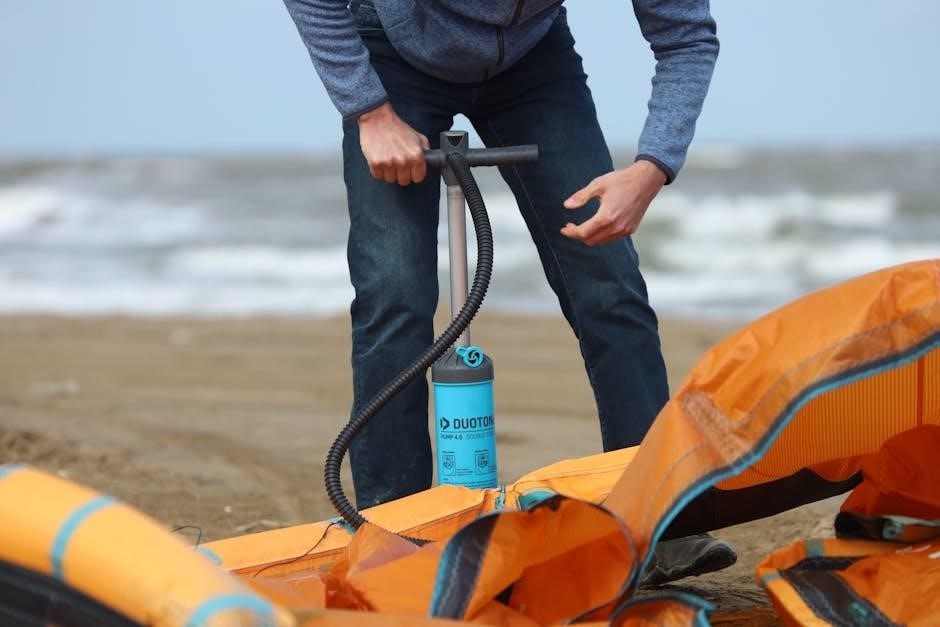what is the requirement of a manual water pump
Manual water pumps are hand-operated devices used to remove water from boats, typically required for sailboats and powerboats between 9 and 12 meters long
Definition and Purpose
A manual water pump is a hand-operated device with a hose used to remove water from a boat, serving as a crucial safety measure to prevent capsizing. The purpose of a manual water pump is to provide a reliable means of removing water from the bilge, thereby maintaining the stability and buoyancy of the vessel. This is particularly important in emergency situations where electrical pumps may be inoperable. By definition, a manual water pump is a simple, yet effective tool that can be easily operated by hand, making it an essential piece of equipment for many types of boats, including sailboats and powerboats.

Requirements for Manual Water Pumps
Manual water pumps are required for sailboats and powerboats between 9 and 12 meters in length to ensure safety measures always
Regulations and Obligations
Regulations specify that sailboats and powerboats must carry a manual water pump on board to ensure compliance with safety standards. These regulations are enforced to prevent accidents and ensure the safety of passengers. The regulations also outline the minimum requirements for manual water pumps, including the capacity and flow rate. Boat owners are obligated to comply with these regulations to avoid penalties and fines. The regulations are in place to protect the safety of boaters and to prevent damage to the boat. Compliance with these regulations is essential for safe boating practices and to prevent accidents. Safety is the top priority.

Types of Boats that Require Manual Water Pumps
Sailboats and powerboats between 9 and 12 meters require manual water pumps typically
Length and Capacity Requirements
The length and capacity of a boat determine the requirement for a manual water pump, with sailboats and powerboats between 9 and 12 meters in length being required to carry one. The capacity of the pump is also important, with larger boats requiring more powerful pumps to remove water quickly and efficiently. The regulations specify the minimum capacity required for different types of boats, ensuring that they can handle emergency situations. The length and capacity requirements are in place to ensure the safety of boats and their occupants, and to prevent accidents caused by flooding. Proper sizing is crucial for effective operation.
Exceptions to Manual Water Pump Requirements
Sailboards and paddle boats are exempt due to self-bailing sealed hulls naturally
Self-Bailing and Sealed Hulls
Self-bailing and sealed hulls are exceptions to manual water pump requirements, as they cannot hold enough water to make the vessel capsize.
These boats have a recess-type cockpit that prevents water accumulation, eliminating the need for a manual water pump.
The design of these hulls allows for natural drainage, making them exempt from the requirement.
This exemption applies to sailboards and paddle boats, which are designed with safety and efficiency in mind.
The sealed hulls and self-bailing features ensure that these boats remain stable and secure, even in rough waters, without the need for a manual water pump.

Bilge Pumping Requirements
Bilge pumping requirements specify minimum capacity and flow rates for manual water pumps on boats with varying lengths and passenger capacities always
Capacity and Flow Rate
Manual water pumps have specific capacity and flow rate requirements, with larger boats needing higher capacity pumps to remove water quickly and efficiently. The flow rate is typically measured in liters per minute, with minimum requirements varying depending on the boat’s length and passenger capacity. For example, boats over 19.8 meters require a minimum flow rate of 190 LPM, while smaller boats may require as little as 38 LPM. These requirements ensure that boats can remove water quickly and safely in emergency situations, and are an important aspect of boat safety regulations and guidelines for manual water pump usage and installation.

Portable Hand Pumps
Portable hand pumps are alternative options for boats requiring manual water pumps with a minimum flow rate of 38 liters per minute capacity
Alternative to Fixed Power Pumps
Portable hand pumps serve as alternatives to fixed power pumps, offering a convenient and reliable means of removing water from boats. They are designed to be compact and lightweight, making them easy to store and transport. With a minimum flow rate of 38 liters per minute, portable hand pumps are capable of effectively removing water from boats, making them a suitable alternative to fixed power pumps. They are often required for boats with specific passenger capacities or lengths, and are an essential piece of safety equipment for many vessels, providing a backup option in case of emergency.
Manual water pumps are essential safety equipment for boats, ensuring crew safety always and effectively.
Importance of Manual Water Pumps
Manual water pumps play a crucial role in ensuring the safety of boats and their crew. They are designed to remove water from the bilge, preventing damage to the vessel and reducing the risk of sinking. The importance of manual water pumps lies in their ability to provide a reliable means of removing water in emergency situations. They are also relatively low maintenance and can be easily operated by hand. Overall, manual water pumps are an essential piece of safety equipment for any boat, and their importance should not be underestimated. They can help prevent accidents and save lives.

